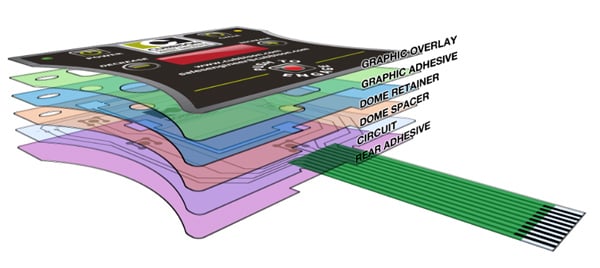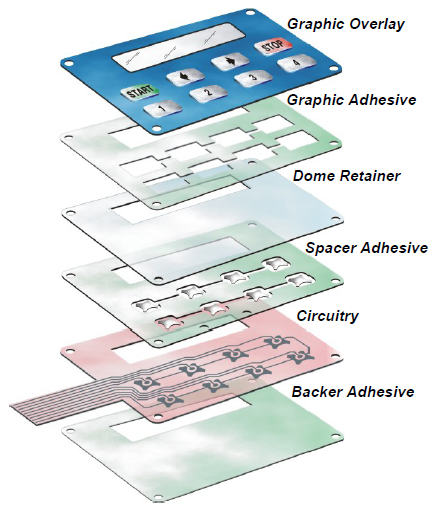How Membrane Switches Enhance User Experience in Tech Gadgets
How Membrane Switches Enhance User Experience in Tech Gadgets
Blog Article
Membrane Layer Change Innovation: The Trick to Dependable and Cost-efficient User Interfaces
Membrane layer button technology has become a crucial component in the design of interface, providing both reliability and cost-effectiveness across a diverse variety of applications. Its durable building and construction ensures resistance to ecological obstacles, while the flexibility in design permits for customized solutions that meet particular sector requirements. As we discover the complex benefits of membrane layer switches, their capacity for technology questions concerning future applications and evolving trends. What does the next phase hold for this modern technology in a significantly electronic landscape?
Comprehending Membrane Switch Over Modern Technology
Membrane layer switch technology is a commonly used interface remedy in numerous digital devices, offering a smooth mix of capability and style. This innovation incorporates numerous layers of products, typically consisting of a visuals overlay, spacer layer, and a circuit layer. The graphic overlay presents the user interface components, while the spacer layer divides the circuit layer from the overlay up until a user triggers a switch.
When pressure is related to the overlay, the circuit layer finishes the electrical circuit, sending out a signal to the gadget. This system enables various arrangements, including responsive comments and backlighting options, boosting user communication. Membrane buttons are normally manufactured making use of resilient products such as polyester or polycarbonate, making sure long life and resistance to environmental aspects like moisture and dirt.
The flexibility of membrane layer switches allows their application in diverse industries, including clinical gadgets, customer electronics, and commercial controls. Their portable style enables combination right into space-constrained environments, giving an efficient customer interface without jeopardizing aesthetic charm. Recognizing the complexities of membrane layer switch innovation is necessary for manufacturers and designers looking for to develop dependable and reliable human-machine interfaces.
Key Advantages of Membrane Switches
While numerous user interface services exist, membrane layer switches over deal distinct advantages that make them a recommended choice in various applications. Among the key benefits is their sturdiness; membrane layer buttons are created to withstand severe environmental problems, consisting of dampness, dirt, and temperature fluctuations, making sure durable efficiency. This resilience considerably decreases the requirement for constant replacements, thus reducing general upkeep prices.

Additionally, membrane buttons are light-weight and small, making them suitable for applications where space is restricted. Their low-profile design adds to a streamlined appearance without compromising functionality.
Cost-effectiveness is additionally a remarkable advantage, as the manufacturing procedure for membrane switches often tends to be less pricey compared to traditional mechanical switches. This price, integrated with their dependability and ease of installment, settings membrane layer changes as a useful service for a variety of markets seeking effective and effective customer interfaces.
Applications Across Numerous Industries
Just how do membrane buttons adapt to the varied requirements of various markets? Membrane button innovation is significantly acknowledged for its versatility, making it ideal for a wide variety of applications throughout several sectors. In the clinical field, membrane layer buttons are used in analysis devices and person monitoring tools, where their sturdiness and convenience of cleaning are critical for preserving health requirements. The auto industry utilizes these buttons in dashboards and control board, supplying a streamlined visual while ensuring easy to use procedure.
In consumer electronic devices, membrane layer buttons provide a small option for remotes and home devices, enhancing user experience with user-friendly layout. In addition, the industrial sector leverages membrane buttons for machinery control board, gaining from their resistance to severe atmospheres, such as wetness and dirt.
Army and aerospace applications additionally utilize membrane switches for their dependability and capability to hold up against extreme conditions, ensuring operational efficiency in critical situations. The food and drink sector embraces these switches for automated systems, where hygiene and simplicity of operation are critical (membrane switch). Inevitably, membrane layer buttons are tailored to meet the unique demands of each sector, confirming their crucial function in contemporary technology interfaces
Layout and Modification Choices

In the realm of membrane button innovation, design and modification choices my link play a critical duty in boosting functionality and customer communication. These switches can be customized to fulfill particular operational needs and visual preferences, making them versatile components in various applications.
One of the main personalization options is the layout of the button itself, which can be made to accommodate one-of-a-kind individual interfaces and ergonomic considerations. By changing the shape, dimension, and arrangement of switches, producers can develop user-friendly layouts that help with convenience of use. In addition, the incorporation of various colors and visuals overlays enables branding and boosted visibility, making certain that users can promptly identify features.
Moreover, membrane buttons can be engineered with different responsive feedback devices, such as raised buttons or distinct clicks, to enhance the individual this contact form experience. Various materials can likewise be picked for sturdiness and ecological resistance, dealing with variables such as moisture, temperature changes, and chemical direct exposure.
Ultimately, the substantial layout and customization choices readily available in membrane layer switch innovation encourage organizations to create tailored options that not just fulfill functional demands however additionally straighten with their branding and operational needs.

Future Fads in Membrane Switches
As membrane switch modern technology remains to evolve, future patterns are progressively concentrated on boosting user experience and integrating sophisticated go to website performances. One substantial fad is the integration of touch-sensitive and capacitive technologies into conventional membrane layer buttons. This growth permits even more instinctive interface, providing tactile feedback while maintaining a sleek design.
Another emerging trend is making use of ecologically friendly materials, driven by the growing demand for sustainable manufacturing practices. Manufacturers are seeking to reduce their carbon footprint by making use of recyclable substratums and low-impact inks, straightening with international sustainability objectives.
Additionally, the surge of the Web of Things (IoT) is triggering the incorporation of wise features into membrane layer buttons. Improved connectivity choices will make it possible for gadgets to connect with each various other, permitting smooth integration into more comprehensive systems.
In addition, innovations in printing modern technologies, such as electronic printing, are enabling greater design adaptability and modification. This allows producers to produce detailed layouts and dynamic colors cost-effectively.

Final Thought
In conclusion, membrane button technology represents an important advancement in customer interface layout, providing substantial advantages in longevity, personalization, and cost-effectiveness. As innovations continue to arise, particularly in touch-sensitive interfaces and lasting materials, the capacity for membrane layer switches to improve customer experience and functionality continues to be appealing.
Report this page